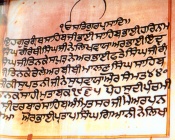Template:AOW83: Difference between revisions
Hari singh (talk | contribs) (New page: <h1 style="margin: 0; background-color:#FFE4E1; font-size: 125%; font-weight:bold; border: 1px solid #ffc9c9; margin-top:.0em; margin-bottom:.2em; padding:0.2em 0.2em; text-align: center;...) |
Hari singh (talk | contribs) No edit summary |
||
| (2 intermediate revisions by the same user not shown) | |||
| Line 1: | Line 1: | ||
<h1 style="margin: 0; background-color:#FFE4E1; font-size: 125%; font-weight:bold; border: 1px solid #ffc9c9; margin-top:.0em; margin-bottom:.2em; padding:0.2em 0.2em; text-align: center; color:#FF6600">[[Structure of SGGS|Structure of Guru Granth Sahib]]</h1> | <h1 style="margin: 0; background-color:#FFE4E1; font-size: 125%; font-weight:bold; border: 1px solid #ffc9c9; margin-top:.0em; margin-bottom:.2em; padding:0.2em 0.2em; text-align: center; color:#FF6600">[[Structure of SGGS|Structure of Guru Granth Sahib]]</h1> | ||
[[Image:Guru Granth Sahib By Bhai Pratap Singh Giani.jpg| | [[Image:Guru Granth Sahib By Bhai Pratap Singh Giani.jpg|175px|thumb|right|]] | ||
The [[Guru Granth Sahib]] begins with the word "[[Ek Onkar]]" – ''The All Pervading Being''. From this Word to the tenth Word “Gur-parshad” is called the [[Mool Mantra]]. After this is the rest of the composition called the [[Japji]] composed by [[Guru Nanak Dev]]. This comprises 38 [[Pauri]]s or stanzas, a Prologue and an Epilogue. This is one of the morning prayer of the Sikhs. | The [[Guru Granth Sahib]] begins with the word "[[Ek Onkar]]" – ''The All Pervading Being''. From this Word to the tenth Word “Gur-parshad” is called the [[Mool Mantra]]. After this is the rest of the composition called the [[Japji]] composed by [[Guru Nanak Dev]]. This comprises 38 [[Pauri]]s or stanzas, a Prologue and an Epilogue. This is one of the morning prayer of the Sikhs. | ||
| Line 8: | Line 7: | ||
The next composition has two parts - (1) "[[So Dar]]" and (2) "[[So Purkh]]". The [[Bani]], "So Dar" contains 5 [[Shabad]]s and "So Purkh" contains 4 [[Shabad]]s. This form most of the evening prayer of the Sikhs and is called the [[Rehras]]. After this is the [[Bani]] called [[Sohila]] (full name, [[Kirtan Sohila]]), which contains 5 [[Shabad]]s and is the bed-time prayer. | The next composition has two parts - (1) "[[So Dar]]" and (2) "[[So Purkh]]". The [[Bani]], "So Dar" contains 5 [[Shabad]]s and "So Purkh" contains 4 [[Shabad]]s. This form most of the evening prayer of the Sikhs and is called the [[Rehras]]. After this is the [[Bani]] called [[Sohila]] (full name, [[Kirtan Sohila]]), which contains 5 [[Shabad]]s and is the bed-time prayer. | ||
Within it's 1430 pages, most of the [[Shabad]]s (hymns) of the [[Sri Guru Granth Sahib]] are arranged in thirty-one [[Raga]]s, the traditional [[India]]n musical measures and scales. Within the [[Raga]]s, they are arranged by order of the [[Sikh Gurus]], with the [[shabad]]s of the [[Hindu]] and [[Muslim]] saints. The shabads are written in various meters and rhythms, and are organized accordingly. For instance, [[Ashtapadi]] - eight steps, or Panch-padi - five steps. The [[Sri Guru Granth Sahib]] is written in [[Gurmukhi]] script, but the shabads were written in many different languages including [[Punjabi]], [[Sanskrit]] and Persian. <big>'''[[Structure of SGGS|....Continued.]]'''</big> | Within it's 1430 pages, most of the [[Shabad]]s (hymns) of the [[Sri Guru Granth Sahib]] are arranged in thirty-one [[Raga]]s, the traditional [[India]]n musical measures and scales. <!---Within the [[Raga]]s, they are arranged by order of the [[Sikh Gurus]], with the [[shabad]]s of the [[Hindu]] and [[Muslim]] saints. The shabads are written in various meters and rhythms, and are organized accordingly. For instance, [[Ashtapadi]] - eight steps, or Panch-padi - five steps. The [[Sri Guru Granth Sahib]] is written in [[Gurmukhi]] script, but the shabads were written in many different languages including [[Punjabi]], [[Sanskrit]] and Persian.---> <big>'''[[Structure of SGGS|....Continued.]]'''</big> | ||
Latest revision as of 13:45, 29 July 2013
Structure of Guru Granth Sahib
The Guru Granth Sahib begins with the word "Ek Onkar" – The All Pervading Being. From this Word to the tenth Word “Gur-parshad” is called the Mool Mantra. After this is the rest of the composition called the Japji composed by Guru Nanak Dev. This comprises 38 Pauris or stanzas, a Prologue and an Epilogue. This is one of the morning prayer of the Sikhs.
The next composition has two parts - (1) "So Dar" and (2) "So Purkh". The Bani, "So Dar" contains 5 Shabads and "So Purkh" contains 4 Shabads. This form most of the evening prayer of the Sikhs and is called the Rehras. After this is the Bani called Sohila (full name, Kirtan Sohila), which contains 5 Shabads and is the bed-time prayer.
Within it's 1430 pages, most of the Shabads (hymns) of the Sri Guru Granth Sahib are arranged in thirty-one Ragas, the traditional Indian musical measures and scales. ....Continued.

